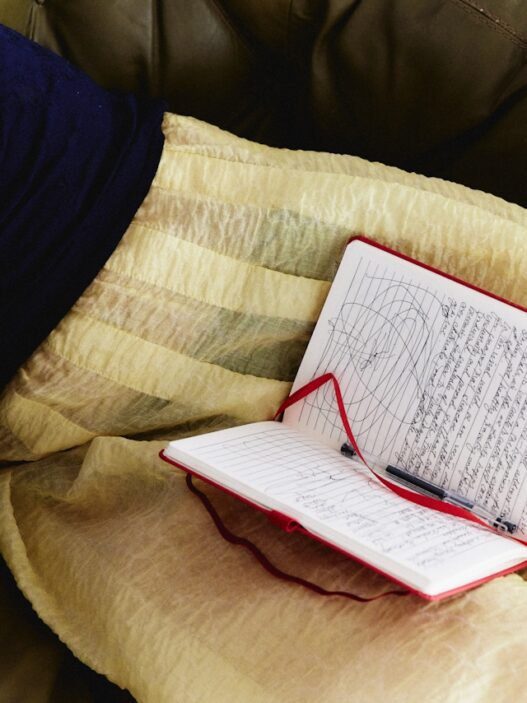Somewhere between TikTok homesteading and your unfinished herbalism course lies the quietly rebellious act of… foraging. Not in a “I drink raw milk and hate sunscreen” kind of way. I’m vegan and I’d wear SPF 600 if I could. And not in a “I’ve decided to move off-grid to ‘reconnect with the land’” kind of way either.. Although I am considering it. So let’s not.
This is more about opting out—when and where we can. It’s about noticing the absurdity of paying $7 for arugula when a plant just as peppery is growing out of the sidewalk. It’s about learning the names of things, not to “return to nature” (whatever that even means), but because we were never really supposed to be this alienated from our food. Or our bodies. Or our ecosystems. For me, foraging is one tiny way to push back against systems that sell us disconnection as convenience.
Also: it’s snacks! Wild snacks. With a side of self-respect.
Feminism, But Make It Edible
Here’s a theory: foraging is deeply feminist. It’s unmonetized. It’s decentralised. It values care, time, and inherited knowledge—things women and femmes have always carried, often without credit. It doesn’t ask for permission. It doesn’t need an algorithm. And it reconnects us to something real. (Which is saying a lot, considering most of us don’t even know what season apples grow in anymore.)
Traditionally, women were the gatherers. We passed on what was safe to eat and what wasn’t. We knew how to treat a cut with yarrow, how to use plantain on a wasp sting, and how to turn bitter greens into dinner. Somewhere between then and now, that kind of knowledge was branded “old wives’ tales” or “witchcraft” and brushed aside in favour of barcodes.
But guess what? Most of those “weeds” still grow. And most of that knowledge is still out there, waiting for us to re-learn it—ideally with humility, curiosity, and full awareness that we are not the first, the originators, or the only ones who know how to live in tune with our environment.
Don’t Be a Cautionary Tale: Ground Rules for Not Dying
If you’re new to foraging (hi, welcome, bring gloves), the first and most important thing is this: don’t be an overconfident idiot. Foraging isn’t just plucking leaves with vibes. It’s science. It’s safety. It’s risk management in cute boots.
Let’s go over the basics:
1. If you can’t ID it with 100% certainty, don’t eat it.
Seriously. This isn’t mushrooms-as-russian-roulette. A misstep with wild plants can land you in the hospital—or worse. Invest in a proper field guide (like any one of these), take a class (like ‘Eat the Planet’ who have tours pretty everywhere), or go with someone who knows what they’re doing.
2. Do your homework—and know your context.
As a settler (hi again), I’m acutely aware that this land has a long and complicated history. Much of what’s “wild” isn’t unclaimed—it’s part of ecosystems and histories we weren’t taught in school. Learn what grows where, and whose land you’re walking on. Don’t forage in protected areas, fragile ecosystems, or someone’s front yard just because you saw chickweed near their porch.
I acknowledge that I’m on the traditional territory of the Mississaugas of the Credit, the Anishinaabeg, the Haudenosaunee, and the Huron–Wendat peoples.
Before you go skipping into the woods with a tote bag and a dream, take a moment to find out whose land you’re on. A good place to start is Native-Land.ca —an interactive map that helps you identify the Indigenous territories, languages, and treaties tied to your location. It’s not perfect or comprehensive, but it’s a useful entry point for learning whose stories shaped the land you’re about to wander.
3. Leave enough behind.
Don’t be greedy. Ethical foraging means leaving plenty for other animals, other people, and the plant’s future self. A good rule of thumb: take no more than a third of what’s available—and only if it’s plentiful.
4. Avoid high-traffic or chemically treated areas.
That patch of clover by the highway? Yeah, don’t eat that. The dog park? Also no. Look for clean soil, low pollution, and wild-ish spaces away from roads, pesticides, or where toddlers with juice boxes regularly pee.
5. Keep it low-key.
Foraging isn’t a performance. You don’t need to post about every wild violet you nibble. You definitely don’t need to drape yourself in moss and call it “healing.” You can just… be a person, outside, learning stuff. That’s enough.
Your Feminist Foraging Starter Kit
To get started, you’re going to need a couple things. But that doesn’t mean you have to spend a lot of money. Most of those things you may already own and the rest can be picked up at your local Dollar Store.
- One solid regional field guide (I like The Boreal Herbal if you’re in Canada)
- A pair of gloves (especially for nettles or thorns)
- Scissors or garden shears (respect the plant—don’t yank)
- A basket or cloth bag
- A notebook or app to track what you find (I use the Obsidian app but Google Keep would work just as well)
- A friend who will stop you from eating that one weird mushroom just because it’s cute
Oh, and a healthy sense of humility. You will mess up. You will learn slowly. That’s fine. That’s part of the point.
Five Wild Things You Can Probably Eat Without Dying
This is not medical advice. Don’t sue me. Please double-check all identifications before consuming anything.
1. Dandelion (Taraxacum officinale)
Your lawn’s enemy, your digestive system’s friend. Every part is edible: leaves (bitter greens), flowers (make fritters or wine), roots (roast them into “coffee”). Bonus points for smugness.

2. Plantain (Plantago major/lanceolata)
The flat, veiny one—not the banana. Excellent for skin irritation and bug bites, and totally edible when young. Tastes a bit like spinach and regret if you don’t cook it right.

3. Lamb’s Quarters (Chenopodium album)
Looks like a weed, acts like a superfood. High in calcium, iron, and sass. Sauté it like spinach or eat raw in small amounts. You’ll never look at a salad the same.
4. Chickweed (Stellaria media)
Delicate, bright, and slightly sweet. A great wild green for salads and sandwiches. Also excellent in salves for itchy skin if you’re crafty like that.
5. Nettles (Urtica dioica)
Yes, they sting. But also yes: they’re nutrient-rich and amazing when cooked. Think iron, magnesium, and deep green flavour. Just wear gloves, okay?

Why Bother?
I get it: your grocery store has kale, and it’s not trying to stab you. So why bother?
Because foraging isn’t just about food. It’s about attention. It’s about getting your hands dirty in a good way. It’s about remembering that food doesn’t have to be bought, branded, or boxed. It can grow on its own—without a supply chain, marketing budget, or sticker price.
It’s also deeply soothing to learn something useful and embodied in a world obsessed with screens and passive consumption. It rewires your brain to see the world differently. Suddenly, a boring alley becomes a buffet. A ditch becomes an herb garden. A walk becomes an act of quiet empowerment.
Nettle & Dandelion Soup for Your Inner Crone

You’ve got your greens so try this super easy wild greens soup! Tastes like autonomy and minerals!!
Ingredients:
-
1 small onion, chopped
-
2 cloves garlic, minced
-
1 medium potato, diced (for body)
-
1–2 cups fresh nettles (use gloves!)
-
1 cup dandelion greens, washed and chopped
-
4 cups veggie broth or water
-
Olive oil or butter
-
Salt, pepper, squeeze of lemon
-
Optional: splash of oat milk or cream, fresh herbs, nutritional yeast
Instructions:
-
Prep your plants.
-
Wear gloves while handling nettles. Blanch them in boiling water for 1 minute, then drain.
-
Dandelion greens can be used raw but chop finely to avoid bitterness overload.
-
-
Sauté the base.
-
Heat a glug of olive oil in a pot. Add onion and garlic, and cook until soft and fragrant. Add diced potato and cook for another 5 minutes.
-
-
Simmer.
-
Add the broth, nettles, and dandelion greens. Bring to a boil, then reduce to a simmer for 20–25 minutes, until potatoes are soft.
-
-
Blend (or don’t).
-
Use an immersion blender for a creamy texture, or leave it chunky and rustic like your rage.
-
-
Season to taste.
-
Salt, pepper, lemon juice. Optional splash of cream/oat milk for softness. Garnish with chives, fresh herbs, or edible flowers if you’re extra.
-
Serves:
2–3 hungry humans plotting change.
Notes:
-
Replace dandelion with spinach if you’re short on weeds.
-
Add chickpeas or lentils to make it a full meal.
-
Serve with sourdough, solidarity, and a good rant.
A Closing Thought
I’m not trying to be an earth witch. I’m not here to pretend foraging will fix capitalism, or save the bees, or make you a better person. But I do believe in small acts of resistance. Quiet ones. Local ones. Ones that reconnect us to ourselves and each other in ways algorithms can’t track.
Foraging won’t save the world. But it might save you a bit—from burnout, from helplessness, from forgetting that you’re capable of learning, doing, and nourishing yourself.
So go outside. Learn one plant. Maybe two. Pay attention. Eat something that didn’t come in plastic. Say thank you—not to the algorithm, but to the dirt.
It’s not a revolution. But it’s a start.
And sometimes, a handful of wild greens is exactly the reminder you need: you’re still here. You’re still learning. And you don’t owe capitalism your lunch.
DISCLAIMER:
This article is for educational and entertainment purposes only. Please do not eat mystery plants just because a zine told you to. I am not a doctor, botanist, herbalist, or forest witch (yet), and while I do own several tote bags and have confidently misidentified plants in the past, that does not make me qualified to diagnose, treat, or encourage you to nibble your neighbour’s hedge.
Always double-check your plant IDs with a legitimate guide, real-life expert, or at least someone who didn’t get their knowledge from Pinterest. Foraging comes with risks—including, but not limited to: stomach aches, stings, regrets, awkward conversations with park staff, and death (rare, but still a real bummer).
Also: don’t forage on private property, protected land, or sacred sites. Don’t trespass. Don’t make salves for your friends without asking them about allergies first. And please—please—don’t sue me if you ignore all of the above and end up hallucinating in a ditch. That part’s on you.
Now go forth, be safe, stay curious, and maybe just start with the dandelions.
Subscribe to The Edit, our weekly(ish) dispatch of subversive media, DIY rebellion, and creative firestarters.
Pitch us your weirdest idea. Write, rant, draw, protest, publish.
Join the New Girl Army. We’re building a magazine from the margins — and we mean it when we say it’s yours, too.
→ Subscribe to The Edit
→ Submit Your Work
→ Follow @shezinemagazine

AXO (she/her) is a multidisciplinary creator, editor, and builder of feminist media ecosystems based in Toronto. She is the founder of She Zine Mag, Side Project Distro, BBLGM Club, and several other projects under the AXO&Co umbrella — each rooted in DIY culture, creative rebellion, and community care. Her work explores the intersection of craft, technology, and consciousness, with an emphasis on handmade ethics, neurodivergent creativity, and the politics of making. She is an advocate for accessible creativity and the power of small-scale cultural production to spark social change. Her practice merges punk, print, and digital media while refusing to separate the emotional from the practical. Above all, her work invites others to build creative lives that are thoughtful, defiant, and deeply handmade.



























